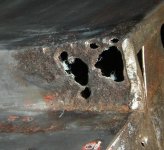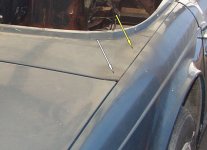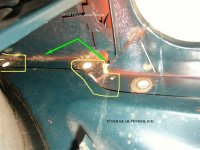Hi,
That area can be a bit tricky to work on.
Have you confirmed that it's rusted from the outside in, not from the inside out? I ask only because the latter is more typical and in that area any visible rust bubbles usually signal more problems down on the flange where the fender bolts up. I'm just concerned that the full extent of the rust problem is fixed, so it doesn't come back in a relatively short time.
But, back to your question....
Looking at the area on my TR4 (which is similar, but not exactly the same, and I don't have access to my TR6 catalogues and reference books right now), I could get a dolly in there without too much trouble, either from inside the cockpit or from the trunk area.
Maybe you can't get a the more typical large one in there on a TR6, but you might be able to get a flat "spoon" dolly behind the panel. Might help to remove the gas tank, too (which would be awfully close to any welding, anyway).
It think I'd be tempted to weld in a patch panel (gas or MIG), dress it and then finishing it all off with a bit of lead (body solder). That way the underlying welded repair needn't be absolutely perfect and I don't really need to do much hammer welding, just get it close.
This is just the sort of place you'll often find lead used. Traditionally it has held up better than Bondo, what with opening and closing the trunk lid. (Doors and hood are other areas it's most useful, for the same reason.)
In fact, right from the factory a lot of Jags from the 50s and 60s have a small patch of lead at each of those corners. With a thin coat of lead blended in properly (worked by hand, never a power sander that throws particles into the air where they can be breathed in!) it will look great. A very thin, skim coat of Bondo might be needed for final blending. The panel is going to at least need localized painting inside and out, any way you approach it.
In fact, I've used brass and then lead to fill in the seams located right there and a couple other places nearby on my TR4, for a somewhat bit cleaner look. (It has more small panels around the trunk opening than the TR6.) That work was done in 1979 and still looks fine. (It's the rest of the lacquer top coats that's degraded in the past 27 years and is now getting taken off and redone). If I have the car media blasted, I'll need to replace any lead. But, if the blaster stays clear of that area I would have no concerns about painting right over the old lead and brass work that was done.
Call me old-fashioned! But I tend to trust the stuff that's been proven over the past 50-100 years, and am just not yet comfortable with some of the modern adhesive bonding methods. The new stuff might work fine, I dunno. But, hey, they can't even keep tiles on the space shuttle and I bet the adhesives NASA uses are a lot better than anything you or I can buy at the local auto body supply.
Let us know what you do.
/ubbthreads/images/graemlins/cheers.gif

 Hi Guest!
Hi Guest!

 smilie in place of the real @
smilie in place of the real @
 Pretty Please - add it to our Events forum(s) and add to the calendar! >>
Pretty Please - add it to our Events forum(s) and add to the calendar! >> 


